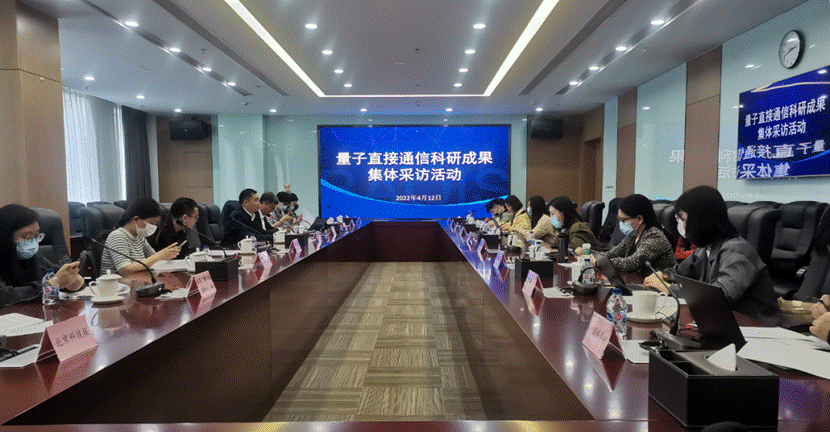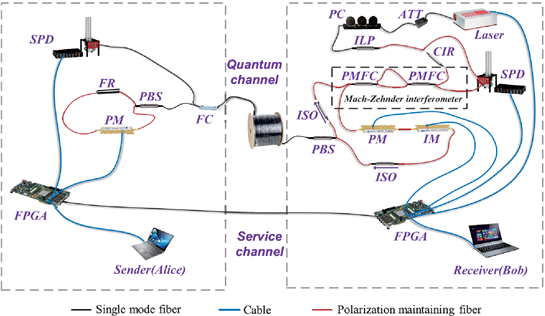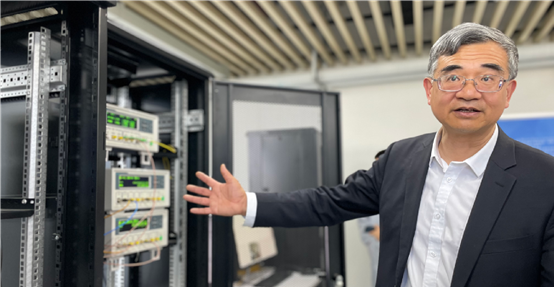Quantum Secure Direct Communication in 100-km Fiber
2022/04/12
Recently, a team of scientists from Gui-Lu Long’s group and Jianhua Lu’s group at Beijing Academy of Quantum Information Sciences and Tsinghua University proposed and realized a new QSDC system. The new system uses phase states for communication and photonic time-bin states for monitoring, respectively, achieving a distance of 100 km in fiber and setting up a new world record.

Figure 1: Group Interview for QSDC at Beijing Academy of Quantum Information Science, on this April 12th.
This new QSDC system can be performed between cities point-to-point and in arbitrarily long-distance via the secure-repeater using off-the-shelf technology. It laid a solid basis to support global quantum network and relevant applications. This work was published online as an article titled ‘Realization of quantum secure direct communication over 100 km fiber with time-bin and phase quantum states’ in Light Science & Application on April 6th, 2022.
In 2000, Prof. Gui-Lu Long and his Ph. D student Xiaoshu Liu proposed the Quantum secure direct communication (QSDC) for the first time. QSDC is able to transmit information securely and directly using quantum states. It advances the reliable communication in noisy channel to reliable and secure communication in both noisy and eavesdropping channel. In 2016, a joint team from Shanxi university and Tsinghua university completed the first demonstration experiment of QSDC. In 2017, several research groups from USTC, Nanjing University of Posts and Telecommunications and Tsinghua University realized demonstration experiments of QSDC using quantum entanglement. In 2019, Gui-Lu Long’s group and Jianhua Lu’s group constructed the first QSDC system in the world, which achieved a 50 bps rate at 1.5 km in fiber. In 2020, they released the world’s first QSDC prototype on the Zhongguancun Forum, a national platform facilitating global exchanges and cooperation on high-tech innovation. The prototype achieved a 4K bps rate at 10 km in fiber; then they increased the distance further to 18 km in the same year. In 2021, a joint team from Shanghai Jiao Tong University and Jiangxi Normal University demonstrated a 15-user QSDC network with point-to-point communication.

Figure 2: Experimental-setup
While only phase states are used in the old systems, this new QSDC system adopts phase states for communication and photonic time-bin states for monitoring respectively, decreasing the effects of noise. Therefore, the new system has a very high stability and a very low intrinsic error rate (the error rate when there are no eavesdroppers). The new system also uses a more powerful LDBCH code. The new system has much increased capacities, distance and communication rate.

Figure 3: Prof. Gui-Lu Long, from BAQIS and Tsinghua University, was introducing the new QSDC system.
The new QSDC system increases the maximum tolerant loss from 5.1 dB to 18.4 dB using a pulsed laser at a frequency of 50MHz, and the communication distance from the previous 18.5 km to a new record of 100 km in fiber, using the off-the-shelf technology. The communication rate reaches to 22.4K bps at 30 km in fiber, which will satisfy the rate requirement of many practical applications. The transmission rate can be increased further using higher repetition pulsed laser.
This work shows that it is possible to perform QSDC between cities point-to-point using off-the-shelf technology. Besides, quantum network using secure-repeaters can be constructed using the classical-secure-repeater technology proposed recently by researchers from Tsinghua University, BAQIS, Nanjing University of Posts and Telecommunications, Southern University of Science and Technology and University of Southampton, facilitating even wider applications.
The published article in ‘Light: Science & Applications’ can be found at:
Haoran Zhang, Zhen Sun, Ruoyang Qi, Liuguo Yin, Gui-Lu Long, and Jianhua Lu. Realization of quantum secure direct communication over 100 km fiber with time-bin and phase quantum states.
https://doi.org/10.1038/s41377-022-00769-w
 中文
中文 Email
Email QCloud
QCloud Log in
Log in
